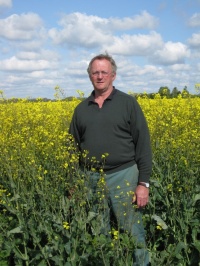
This is the first time that John Lockhart of C W and J Cargill Ltd, based at Nova Scotia Farm, West Caister, has ever grown oilseed rape after losing his Bird’s Eye Pea contract last year.
He drilled the 60ha (three fields) of Compass oilseed rape on 1 st September and the fields were all established using a plough and then drilled with a Vaderstad drill. The marsh land is silty loam soil around a metre above sea level and the rest is sandy loam on higher ground.
‘We were careful to sow the exact number of seeds per square metre and made sure that the TGW was correct for the seed before planting, so that our seed rate calculations could be as accurate as possible’ said John. ‘Originally, the main reason we chose Compass was for its high oil content, being one of the top candidate varieties to go onto the HGCA list, helping to guarantee more income at harvest, especially with the prices being as high as they are. Other considerations were the quick establishment, vigour and ability to get away in the autumn which this variety is renowned for.’
John’s first year of growing oilseed didn’t turn out to be as hassle free as he originally expected. Two of the fields on the marshes were decimated by around 150 swans which arrived in early December, some staying put until the middle of April. The swans stripped the rape leaves to the stalks, leaving a brown and rather poached field. No bird scarer would shift them. Luckily they were relatively selective, leaving the centre shoot which holds the main growing point. The fields started re-growing in the spring, especially after nitrogen application, but the swans kept feeding. Finally by the start of March the number of swans had reduced to around 50 giving the field a real chance to recover. Today looking at the two fields compared to the other field located elsewhere on the farm you can see very little difference.
‘In hindsight we were very lucky that we had chosen such a vigorous hybrid which was more than able to recover so quickly in the spring when we really needed it’ said John. He went on to say, ‘ in January we were very worried that we wouldn’t have a crop to market at all.’
‘Considering we haven’t had any rain since early March, the crop is standing tall and looking healthy. We can see the pods forming nicely,’ he adds. ‘We have recently purchased a Bison header to attach to the front of the combine to make harvesting easier. So I’m looking forward to taking the crop to harvest and hopefully it will yield well, being on virgin land.’